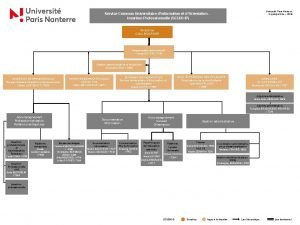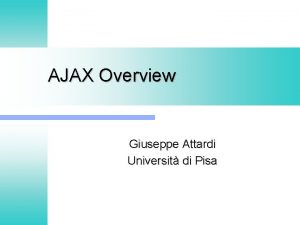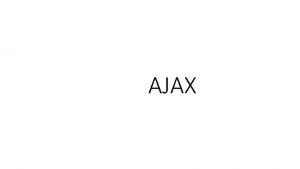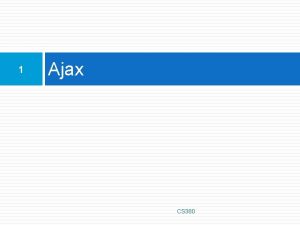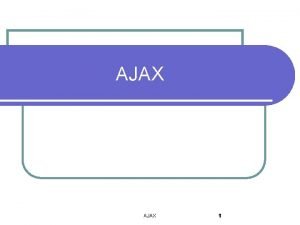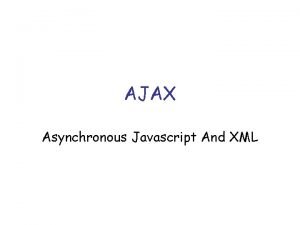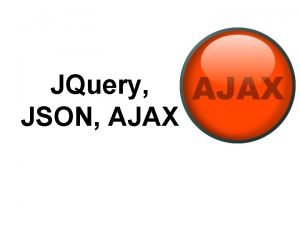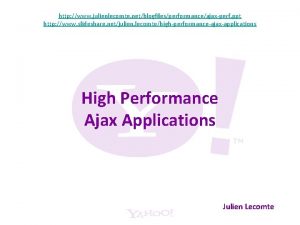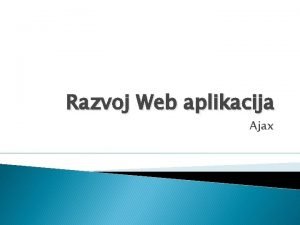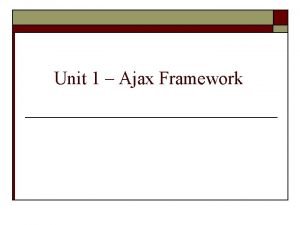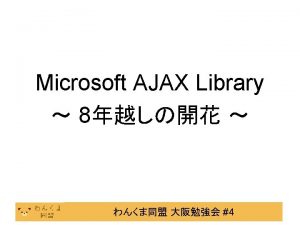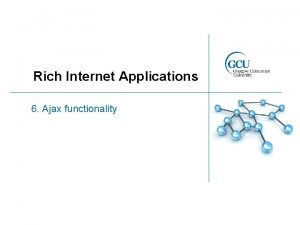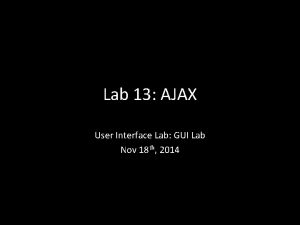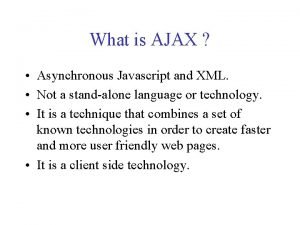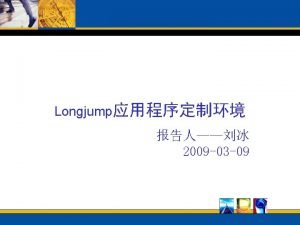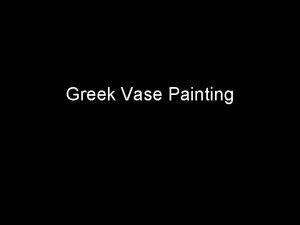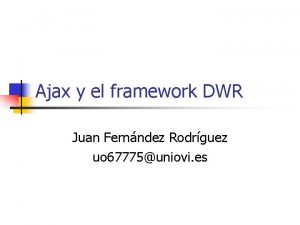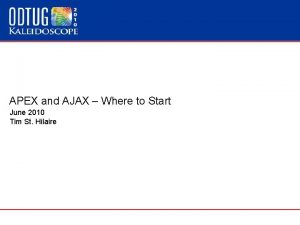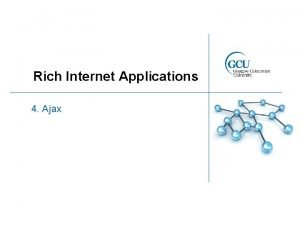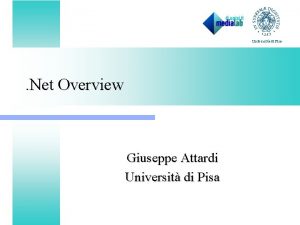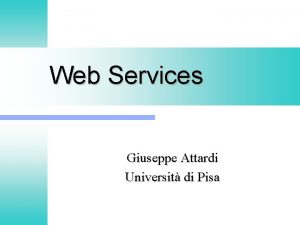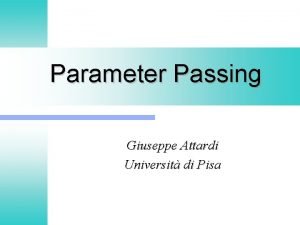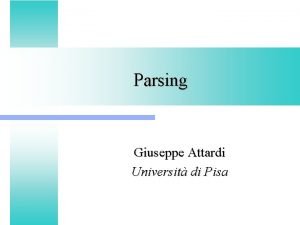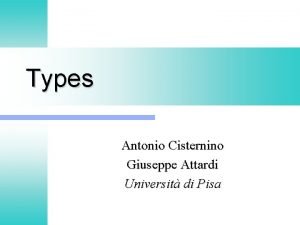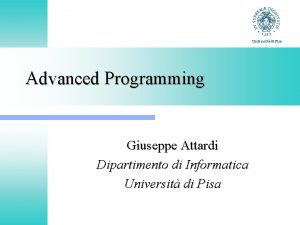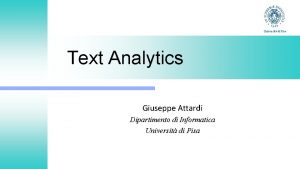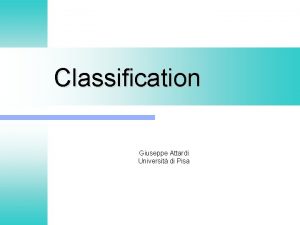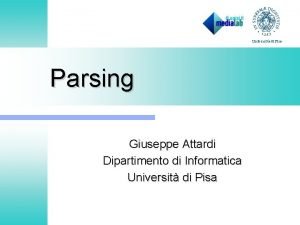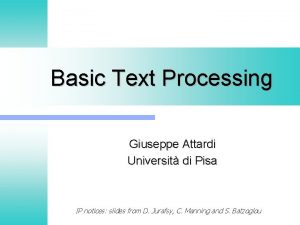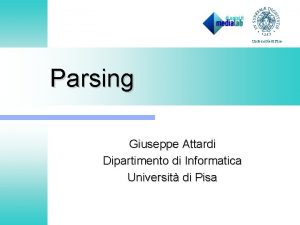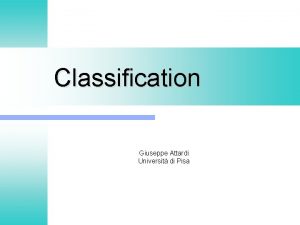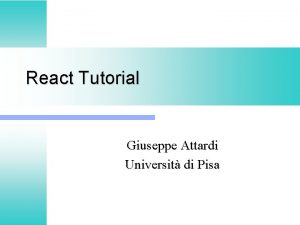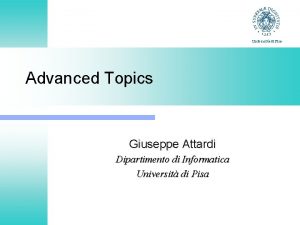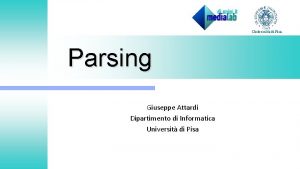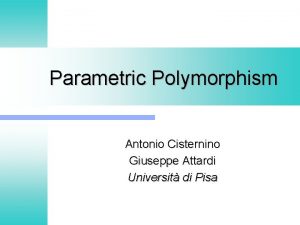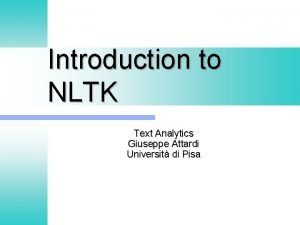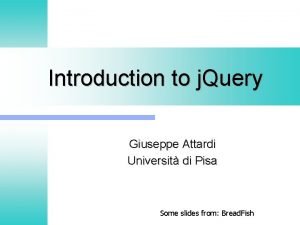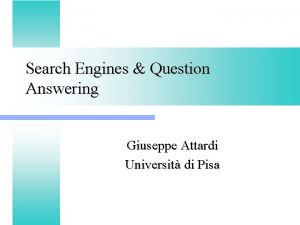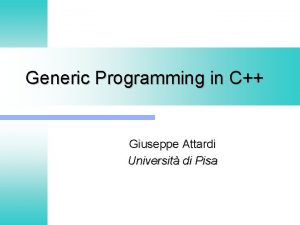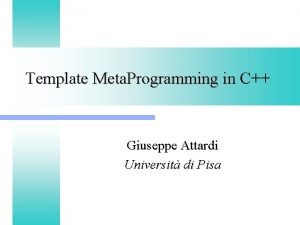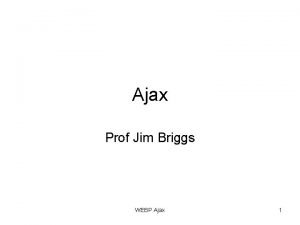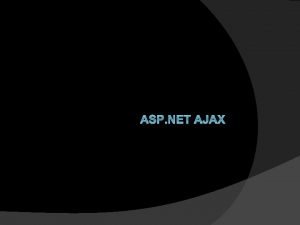AJAX Overview Giuseppe Attardi Universit di Pisa AJAX

































- Slides: 33

AJAX Overview Giuseppe Attardi Università di Pisa

AJAX l l l Asynchronous Java. Script And XML Catchy acronym coined by Jesse James Garrett of Adaptive Path (February 2005) Really a set of techniques used as far back as 1998 But came into vogue with new browsers supporting Xml. Http. Request() and broadband connections Killer Apps: Gmail and Google Maps

Google Maps • Live content refresh and manipulation without page refreshes • API for easy integration with other data sources

Flickr • Dynamic AJAX • • • “photostream” slideshows User-driven tagging User comments and permalinking RSS feeds

Ajax Requirements l DHTML capable browsers § DOM, CSS, XHTML XHR support across all browsers l Broadband connections l § AJAX-based Java. Script can take considerable bandwidth to download

Main features of AJAX The Web page hosts entire Java. Script programs l The UI is manipulated programmatically and in real-time by changing the Document Object Model l The Web page isn’t reloaded unless completely new functionality is needed l Information is accessed in the background (asynchronously) by the browser via Web services l § XML, JSON, or anything HTTP can transmit

Ajax Model Source: Garrett(2005)

Ajax Asynchronous Model Source: Garrett(2005)

The Result Pure browser software that can become Rich Interactive Application (RIA) l The Web becomes a true software platform l An open software model that has no owner l § Not vendor controlled, based on neutral, open Web standards l A significant challenge as the browser client suddenly becomes quite complex

Ajax Application Frameworks

AJAX Alternatives l IFrame § Standard HTML l Macromedia Flash § Requires a plug-in • Provided for almost every browser l Java Web Start/Applets § Requires a runtime preinstalled MS. NET, One Touch Deployment l Silverlight l § Requires a preinstalled plug-in

IFrame l Put on a page: <iframe id="buffer" style="visibility: hidden; display: none; height: 1 px“ onload=“some action"></iframe> l Fill it from a URL: <a href="date" id="display" target="buffer">Load me</a> l Action: var l=document. get. Element. By. Id('display'); var f=window. frames['buffer']. document. body; if (f. inner. HTML != '') l. inner. HTML=f. inner. HTML

AJAX Limitations l Handheld device browsers provide limited support for Ajax technologies

Implementing AJAX l To implement AJAX we need to answer three questions: § What triggers the AJAX request? • Usually a Java. Script event (onblur, onclick, etc. ) § What is the server process that handles the AJAX request and issues the response? • Some kind of URL (use a Service Locator) § What processes the response from the server (what is the callback method)? • A Java. Script function that gets the response and manipulates the DOM, based on the text returned

Xml. Http. Request Object (XHR) The heart of AJAX l First implemented in IE in 1997 as part of the new DHTML standard l Response comes in one of two properties: l § response. XML – Returns a DOM document (can use functions such as, get. Element. By. Id()) § response. Text – A text string (can be HTML, or even Java. Script code)

XHR: Creating function get. XMLHTTPRequest() { var xhr = null; if (window. XMLHttp. Request) { // most modern web browsers xhr = new XMLHttp. Request(); } else if (window. Active. XObject) { // Internet Explorer xhr = new Active. XObject("Microsoft. XMLHTTP"); } // else stone age web browsers return xhr; } Test it: http: //medialab. di. unipi. it/test/ajax. html

XHR: Simple RPC function rpc(url) { var args = rpc. arguments; var uri = url + '? '; if (args != null) { for (var i = 1; i < args. length; i++) { if (i > 1) uri += '&'; uri += "arg" + i + '=' + escape(args[i]); } } var x = new get. XMLHttp. Request(); x. open("GET", uri, false); x. send(null); if (x. status != 200) return null; var res = x. response. Text; delete x; return res; }

XHR: Sending the Request function send. Request(url, params, call. Back) { var req = new XMLHttp. Request(); closure req. onreadystatechange = function() { call. Back(req); }; req. open(“POST”, url, true); req. set. Request. Header("Content-Type", "application/x-www-form-urlencoded"); req. send(params); } true = asynchronous

XHR: Using a callback handler var var var READY_STATE_UNINITIALIZED = 0; READY_STATE_LOADING = 1; READY_STATE_LOADED = 2; READY_STATE_INTERACTIVE = 3; READY_STATE_COMPLETE = 4; function on. Ready. State. Change(req) { var ready = req. ready. State; var data = null; if (ready == READY_STATE_COMPLETE) { data = req. response. Text; } else { data = "loading. . . [" + ready + "]"; } //. . . do something with the data. . . }

Handling the Response l Response can be one of the following: § Formatted data (XML, other custom format) • XMLHttp. Request. response. XML • Decouples the server from presentation issues • Could perform XSLT transformation on returned XML § HTML • XMLHttp. Request. response. Text • Server generates HTML, script “injects” HTML via inner. HTML • Server is now concerned with presentation § Java. Script • XMLHttp. Request. response. Text • Use the eval() Java. Script command • Again, our server code is concerned with presentation

AJAX Concerns l Security § Same Origin Policy Browser compatibility l Accessibility l The Back button l What if Java. Script is turned off? l

Same Origin Policy l Cross-Origin Resource Sharing § Adds new HTTP headers: • Origin • Access-Control-Allow-Origin l JSONP § Send JSON data containing a <script> element which when loaded performs callback from a different domain l Web. Sockets (HTML 5)

JSONP l HTML page contains Convention: tell the server to send back code to be used for callback to do parse. Response <script type="application/javascript“ src="http: //s. com/Users/1234? callback=parse. Response"> </script> l The server at the specified URL returns code: parse. Response({"Name": "Foo", "Id": 1234, "Rank": 7}); where: {"Name": "Foo", "Id": 1234, "Rank": 7} l is the JSON data for the original request l The browser load the script and runs it, i. e. invokes parse. Response() l

Web. Sockets Protocol providing full-duplex communication channels over a single TCP connection l Uses prefix ws: // or wss: // l Included in HTML 5 l

AJAX and the Back Button Huge usability issue l Returning to the previous state may not be possible when a page is updated dynamically l Difficult to bookmark on a particular page state l

AJAX Libraries l l l l j. Query Prototype Scriptaculous Yahoo! UI Library GWT ASP. NET AJAX DOJO …

Server Side Frameworks DWR (Java) l Ruby on Rails (Ruby) l Symfony 2, Laravel (PHP) l

Direct Web Remoting

Comet Generic term for web application model in which a long-held HTTP request allows a server to push data to a browser l Implementations: l § Persistent connection § Hidden i. Frame § XMLHttp. Request

Persistent Connection HTTP 1. 0: Connection: keep-alive (< 5 -15 sec. )

RIA with Ajax

Ajax, Client/SOA, and Mashups Common Elements: l Zero footprint apps l No plug-ins or admin rights needed l Leverages Web services l Dynamic user interface l Java. Script powered l Can be made secure l With a little work, can communicate and combine data from Web services anywhere in the world l Easier with pre-built widgets, frameworks, IDEs, and Web service stacks l Gives us new Web components. . .

Ajax for Software Composition
 Gerardo attardi
Gerardo attardi Universit of london
Universit of london Nanterre universit
Nanterre universit Universit
Universit Universit sherbrooke
Universit sherbrooke Erasmus universit
Erasmus universit Ajax overview
Ajax overview Ajax introduction
Ajax introduction Ajax xhtml
Ajax xhtml Ajax cs
Ajax cs Ajax scales
Ajax scales Ajax.l
Ajax.l Ajax svg
Ajax svg Asynchronous javascript and xml
Asynchronous javascript and xml Ajax async
Ajax async Ajax edition
Ajax edition Ajax ppt
Ajax ppt Ajax
Ajax Microsoft ajax content delivery network
Microsoft ajax content delivery network What is ajax? *
What is ajax? * 大阪 microsoft asp
大阪 microsoft asp Ajax patterns
Ajax patterns Google maps ajax
Google maps ajax Ajax gui
Ajax gui What is ajax
What is ajax Jsp ajax 예제
Jsp ajax 예제 Ajax
Ajax Frenotomy ajax
Frenotomy ajax Exekias achilles and ajax playing a dice game
Exekias achilles and ajax playing a dice game Dwr vs ajax
Dwr vs ajax Wwv_flow.ajax
Wwv_flow.ajax Ajax
Ajax Jquery sqlite
Jquery sqlite Rich internet applications with ajax
Rich internet applications with ajax


